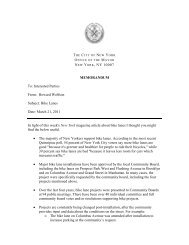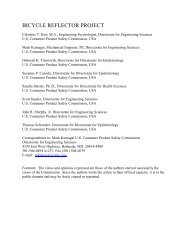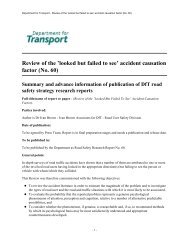Guide for the Development of Bicycle Facilities - The Industrialized ...
Guide for the Development of Bicycle Facilities - The Industrialized ...
Guide for the Development of Bicycle Facilities - The Industrialized ...
Create successful ePaper yourself
Turn your PDF publications into a flip-book with our unique Google optimized e-Paper software.
guide <strong>for</strong> <strong>the</strong> development <strong>of</strong> bicycle facilities 21<br />
<strong>The</strong>re are instances where it is necessary to sign a route to direct bicyclists<br />
to a logical destination; however, <strong>the</strong> route does not <strong>of</strong>fer any <strong>of</strong> <strong>the</strong><br />
above signed shared roadway criteria. In such cases, <strong>the</strong> route should not<br />
be signed as a bike route, although destination signing may be advisable.<br />
A typical application <strong>of</strong> destination signing would be where bicyclists<br />
are directed <strong>of</strong>f a highway to bypass a section <strong>of</strong> freeway. Special signs<br />
would be placed to guide bicyclists to <strong>the</strong> next logical destination, much<br />
as motorists would be directed if a highway detour were required. In urban<br />
areas, signs typically would be placed every 500 m (approximately<br />
every 1/4 mile), at all turns, and at major signalized intersections.<br />
M7 series sign<br />
D11-1<br />
Optional Destination Signing<br />
In urban areas, signs should be placed every 500 m (approx. 1/4 mile),<br />
at every turn, and at all signalized intersections.<br />
Figure 4. Typical Signed Shared Route Signing<br />
Design<br />
Signed Shared Roadways





